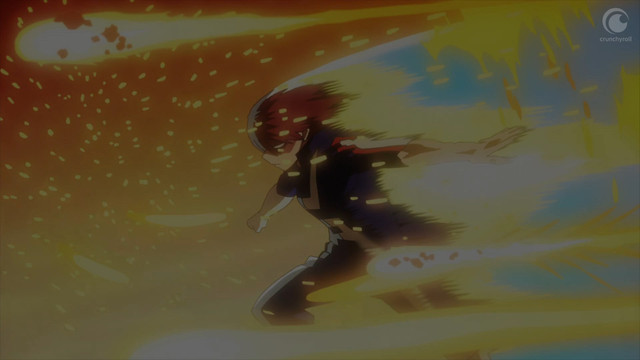Hey all, and welcome back to Why It Works! If you’ve been following this column in recent weeks, you know that I’m kinda losing it over the My Hero Academia sports festival. This arc feels like a note-perfect articulation of what makes shonen tournament arcs so fun, with the mix of tactics, character arcs, and beautiful visuals all coming together to make something that hits on every level. But even by the standard set so far, last week’s Deku-Todoroki battle was a triumph. Bringing the arc’s focus on familial legacy to a fever pitch and demonstrating Deku at his most resilient and desperate, this battle was an all-timer.

There are all sorts of reasons why last week’s fight was so effective, and you certainly know I’d be willing to discuss them. But today I thought I’d highlight something that got short stick while discussing Uraraka’s more storytelling-focused battle - the animation.
Deku and Todoroki’s fight was defined by sumptuous, thrilling animation from start to finish, offering not just “beautiful movement,” but sequences specifically dedicated to articulating dramatic points of the battle. Concepts like Deku’s pain and Todoroki’s fully unleashed power were made clear not just in narrative, but in wholly visual terms, reflecting how animation is itself a kind of storytelling. And in the end, Deku and Todoroki’s final clash was depicted in all its absurd glory, courtesy of one of my favorite animators - Yutaka "Yutapon" Nakamura.

Yutaka Nakamura is a very talented and somewhat unique figure within anime. The vast majority of talented animators in the anime industry don’t work for any one company - they’re freelancers, hired for specific projects or cuts, but always available to work on other projects. On the one hand, this is reflective of the anime industry’s extremely tenuous financial situation, where far too few talented workers can rely on a stable salary. On the other, it means animators can specialize not just within a company, but within the industry itself, working on the projects where their skills are most applicable.
Yutaka Nakamura is different. Instead of spreading his work throughout the industry, Nakamura works pretty much exclusively on BONES projects, and has done so for years. The company presumably understands what a talented animator they have in Nakamura, and so he’s one of the few key animators who’s actually kept on retainer. And if you look at his work, it’s easy to see why.
Like many of the best animators, Nakamura’s work has some clear quirks that generally come through regardless of the projects. He’s closely associated with action animation, particularly effects-heavy action animation, and has a specific, geometry-focused method of conveying energy, explosions, and debris. His work has prompted the term “Yutapon Cubes” to describe his style of explosions, where the impact of some great attack breaks the terrain into a bunch of segmented rectangles, which then fly off in all directions. The term is a little reductive, but it nicely reflects how his animation works to create not just a sense of character motion, but physical consequence - the scale of his characters’ actions impacts the terrain in a way that’s coherent enough for the audience to feel blown back by the force of some attack.
That sense of impact and consequence, along with his remarkable eye for shifting spatial compositions (something only possible because he likely storyboards his own scenes), is what really grabs me in his work. Though he’s handled more realistic action scenes in the past (his work on Cowboy Bebop and Sword of the Stranger offer some stunning examples), he’s more recently leaned much more heavily into effects-driven work, and his ability to lend outrageous, fantastical conflicts a sense of meaningful punch is remarkable. It’s very easy to make fantastical or energy-focused attacks seem insubstantial, but the way Nakamura paces his segments, and how he lets energy overwhelm clear images in very specifically chosen methods, conveys a sense of impact even in the most fanciful of circumstances. Todoroki’s graceful but very methodical movements in his recent fight are a great example, where his physical action contrasts with the wild fire and ice around him to create a sense of overwhelming power. His terrific cut in the first episode of Blood Blockade Battlefront is another, where the careful management of fast and slow motion creates a sense of dramatic pull even though the overt narrative actions are almost incomprehensible.
Nakamura’s style is distinct enough that at this point, it almost feels like he’s “typecast” into this kind of environment-embracing, effects-heavy work - but given his key role in so many productions, I have to assume this is the work he wants to be doing. And beyond that, his previous work demonstrates that he certainly has dramatic range, at least when it comes to action animation. Either way, I was thrilled to see him bring so much life to Deku and Todoroki’s battle, and I hope to see more of his wonderful work for many years to come.
-----
Nick Creamer has been writing about cartoons for too many years now, and is always ready to cry about Madoka. You can find more of his work at his blog Wrong Every Time, or follow him on Twitter.
No comments:
Post a Comment